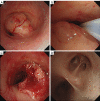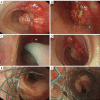Alfentanil and propofol induced anesthesia for patients with huge endotracheal tumor undergoing fiberoptic bronchoscopic interventional therapy: case report
- PMID: 36093539
- PMCID: PMC9459539
- DOI: 10.21037/tcr-22-199
Alfentanil and propofol induced anesthesia for patients with huge endotracheal tumor undergoing fiberoptic bronchoscopic interventional therapy: case report
Abstract
Background: There is a high risk of hypoxia or apnea for patients with huge tracheal tumor during general anesthesia. Here we reported two cases of extremely huge endotracheal tumors undergoing fiberoptic bronchoscopic interventional therapy under general anesthesia. We hope the experience will be of reference value for formulating reasonable anesthesia scheme for such critically ill patients.
Case description: The two patients were accompanied with severe respiratory distress. And fiberoptic bronchoscopy revealed that the trachea cavity was blocked nearly completely by extremely huge tracheal tumor. Tracheal tumors were scheduled to be removed with fiberoptic bronchoscopic interventional therapy. General anesthesia was inducted with alfentanil and propofol. Then a laryngeal mask was inserted and spontaneous breath was preserved. During the operation, complete airway obstruction occurred, but it was effectively handled by using the fiberoptic bronchoscope to push the tumor and reopen the gap between the mass and the tracheal wall. After the therapy, the patients' symptom of respiratory distress was relieved significantly.
Conclusions: For patients with huge tracheal tumor that to be handled with fiberoptic bronchoscopic interventional therapy, general anesthesia with spontaneous breath induced by alfentanil and propofol is preferable. The most important, when complete airway blockade occurs during the process, pushing the tumor and reopening the respiratory tract with fiberoptic bronchoscope is a fairly effective solution to enable patients to be reoxygenated.
Keywords: Alfentanil; case report; endotracheal tumor; fiberoptic bronchoscopic interventional therapy; general anesthesia.
2022 Translational Cancer Research. All rights reserved.
Conflict of interest statement
Conflicts of Interest: All authors have completed the ICMJE uniform disclosure form (available at https://tcr.amegroups.com/article/view/10.21037/tcr-22-199/coif). The authors have no conflicts of interest to declare.
Figures


Similar articles
-
Fiberoptic bronchoscopy-assisted endotracheal intubation in a patient with a large tracheal tumor.Int Surg. 2015 Apr;100(4):589-92. doi: 10.9738/INTSURG-D-14-00020.1. Int Surg. 2015. PMID: 25875537 Free PMC article.
-
Clinical application of fiberoptic bronchoscope combined with visual laryngeal mask awake tracheal intubation technique: a case report.Am J Transl Res. 2023 Feb 15;15(2):1462-1468. eCollection 2023. Am J Transl Res. 2023. PMID: 36915732 Free PMC article.
-
Fiberoptic tracheal intubation through a classicial laryngeal mask airway under spontaneous ventilation in a child with Treacher Collins syndrome.Acta Anaesthesiol Taiwan. 2006 Dec;44(4):223-6. Acta Anaesthesiol Taiwan. 2006. PMID: 17233367
-
Anesthesia for bronchoscopy and interventional pulmonology: from moderate sedation to jet ventilation.Curr Opin Pulm Med. 2011 Jul;17(4):274-8. doi: 10.1097/MCP.0b013e3283471227. Curr Opin Pulm Med. 2011. PMID: 21519266 Review.
-
Tracheal myoepithelioma resected by using rigid bronchoscopy: a case report and review of the literature.J Cardiothorac Surg. 2022 May 23;17(1):125. doi: 10.1186/s13019-022-01880-0. J Cardiothorac Surg. 2022. PMID: 35606819 Free PMC article. Review.
Cited by
-
Comparison of the Safety and Efficacy of Remimazolam Besylate versus Dexmedetomidine for Patients Undergoing Fiberoptic Bronchoscopy: A Prospective, Randomized Controlled Trial.Drug Des Devel Ther. 2024 Jun 18;18:2317-2327. doi: 10.2147/DDDT.S460949. eCollection 2024. Drug Des Devel Ther. 2024. PMID: 38915861 Free PMC article. Clinical Trial.
-
Modified Dixon sequential method to determine the effective dose of alfentanil compounded with propofol for day-case hysteroscopy.Ther Adv Drug Saf. 2023 Dec 6;14:20420986231214992. doi: 10.1177/20420986231214992. eCollection 2023. Ther Adv Drug Saf. 2023. PMID: 38074416 Free PMC article.
References
Publication types
LinkOut - more resources
Full Text Sources
Miscellaneous
